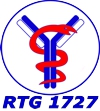MD TP66: Role of IL-13 in the pathogenesis of experimental systemic sclerosis
Systemic sclerosis is a severe autoimmune connective tissue disease which is characterized by autoimmunity, vasculopathy and fibrosis (1). SSc has a worldwide distribution with prevalence of SSc from 20 to 260 case per million in different populations and affects women more than men (2). Disease manifestation appears to be rather heterogeneous with strong individual differences between the patients. Besides involvement of skin, the involvement of many other inner organs have been have been commonly observed in patients (3). The pathogenesis of the development of SSc is only partially known. Interestingly, it has been demonstrated thatautoantibodies specific for the angiotensin receptor-1 (AT1R) are potentially pathogenic for SSc (4,5).
Animal models, particularly mouse models, are powerful research tools helping us to understand disease pathogenesis (6). Recently, we established a novel mouse model for SSc by immunizing mice with human AT1R. After immunization, mice generate autoantibodies against AT1R. Moreover, several SSc-like features, such as skin fibrosis, skin perivascular infiltration of inflammatory cells, and lung inflammation characterized by both interstitial and perivascular infiltrates. Notably, although this novel mouse model is featured by skin fibrosis and lung inflammation, lung fibrosis, an important hallmark of SSc, is not observed. These findings suggest that the pathogenesis of fibrosis in skin and lung is differentially regulatedand development of lung fibrosis might require additional regulatory signals which are absent in our model.
Fibrosis is believed to be associated with the expression of Th2 cytokines such as IL-4 and IL-13 (7). Moreover, IL-13 expressed in the skin of SSc-patients augments skin fibrosis (8) and enhances collagen production of pulmonary fibroblast in human asthmatics (9). However, despite to several other cytokines, no significant upregulation of IL-17 could be detected in the lungs of experimentally diseased mice in our SSc model. Recently, an IL-13-over-expressing transgenic mouse strainhas become a favoriteexperimental tool for research in the field of pulmonary diseases at our institute. Wild type mice infected with M. tuberculosis (MTB) develop lung inflammation but lack granuloma formation, a key feature of human tuberculosis. By contrast, both lung inflammation and necrotizing granulomas occur inIL-13-over-expressing transgenic miceafter MTB infection (10), suggesting that IL-13 is an essential cytokine in the development of lung pathology.
According to our hypothesis, development of lung fibrosis in SSc requires beside autoimmunity to AT1R the expression of IL-13, which is observed in patients but not in our disease model. We will prove this hypothesis by immunizing IL-13-over-expressing transgenic mice with AT1R in our mouse model for SSc.
Literature:
1. Abraham DJ, Varga J. Scleroderma: from cell and molecular mechanisms to disease models. Trends Immunol 2005 Nov;26(11):587-95.
3
2. Ranque B, Mouthon L. Geoepidemiology of systemic sclerosis. Autoimmun Rev 2010 Mar;9(5):A311-A318.
3. Bussone G, Mouthon L. Interstitial lung disease in systemic sclerosis. Autoimmun Rev 2011 Mar;10(5):248-55.
4. Becker MO1, Kill A, Kutsche M, Guenther J, Rose A, Tabeling C, Witzenrath M, Kühl AA, Heidecke H, Ghofrani HA, Tiede H, Schermuly RT, Nickel N, Hoeper MM, Lukitsch I, Gollasch M, Kuebler WM, Bock S, Burmester GR, Dragun D, Riemekasten G.Vascular receptor autoantibodies in pulmonary arterial hypertension associated with systemic sclerosis.Am J Respir Crit Care Med. 2014 Oct 1;190(7):808-17.
5. Riemekasten G, Philippe A, Näther M, Slowinski T, Müller DN, Heidecke H, Matucci-Cerinic M, Czirják L, Lukitsch I, Becker M, Kill A, van Laar JM, Catar R, Luft FC, Burmester GR, Hegner B, Dragun D.Involvement of functional autoantibodies against vascular receptors in systemic sclerosis.Ann Rheum Dis. 2011 Mar;70(3):530-6.
6. Morin F, Kavian N, Batteux F.Animal models of systemic sclerosis.Curr Pharm Des. 2015;21(18):2365-79.
7. Huang XL, Wang YJ, Yan JW, Wan YN, Chen B, Li BZ, Yang GJ, Wang J.Role of anti-inflammatory cytokines IL-4 and IL-13 in systemic sclerosis.Inflamm Res. 2015 Apr;64(3-4):151-9.
8. Fuschiotti P, Larregina AT, Ho J, Feghali-Bostwick C, Medsger TA Jr.Interleukin-13-producing CD8+ T cells mediate dermal fibrosis in patients with systemic sclerosis.Arthritis Rheum. 2013 Jan;65(1):236-46.
9. Firszt R, Francisco D, Church TD, Thomas JM, Ingram JL, Kraft M. Interleukin-13 induces collagen type-1 expression through matrix metalloproteinase-2 and transforming growth factor-beta1 in airway fibroblasts in asthma. Eur Respir J (2014) 43:464–73.
10. Heitmann L, Abad Dar M, Schreiber T, Erdmann H, Behrends J, Mckenzie AN, Brombacher F, Ehlers S, Hölscher C.The IL-13/IL-4Rα axis is involved in tuberculosis-associated pathology.J Pathol. 2014 Nov;234(3):338-50.

- Projects
- Projects
- Associated projects
- MD projects
- MD TP51 - Humanized mouse model for systemic sclerosis...
- MD TP63 - Investigating pemphigus vulgaris pathogenesis using a human skin organ culture model
- MD TP64 - Expression of C5aR1 and C5aR2 in skin biobsies of bullous pemphigus patients
- MD TP65 - Expression of AT1R, ETAR, CXCR3 and CXCR4 in lungs of ApoE knockout mice
- MD TP66 - Role of IL-13 in the pathogenesis of experimental systemic sclerosis
- MD TP67 - Experimental mouse model for Pemphigus vulgaris
- MD TP68 - Elucidating the mechanisms of IL-10 production in plasma cells
- MD TP69 - Establishment and utilization of a 3D-model of human skin for translational utilisation
- Associated MD projects
- Concluded projects






